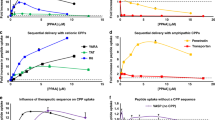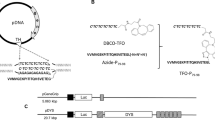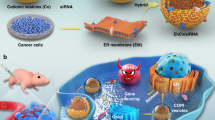Abstract
There are several strategies that can be utilized to improve transfection efficiency while reducing the cytotoxicity of polyethyleneimine (PEI) as a promising non-viral gene delivery vector. In this study, we evaluated the potential use of lysine–histidine (KH) peptides in modifying the PEI 10 kDa structure and enhancing its efficiency while maintaining low toxicity of PEI. PEI 10 kDa was modified with 6-bromohexanoic acid (alkyl) to increase its lipophilicity. Then, ethylenediamine (EDA) was attached to the carboxylic groups of PEI-hexanoate to restore the primary amines of PEI. Subsequently, six different KH short peptides were conjugated to PEIs and evaluated for the effect of the KH sequence on vector transfection efficiency and cytotoxicity. The transfection efficiency of PEI-peptides complexed with a luciferase reporter gene (pRLCMV) in Neuro-2A murine neuroblastoma cells showed that the PEI conjugated to KHHHKKHHHK peptide had a significantly higher rate of gene transfection efficiency in comparison with other KH peptides. This peptide was conjugated to PEI-alkyl and PEI-alkyl-EDA and significant improvement in efficiency with minimal cytotoxicity was observed. The results obtained suggest that the sequence and content of KH peptides will have a significant impact on the transfection efficiency of modified PEI 10 kDa.
This is a preview of subscription content, access via your institution
Access options
Subscribe to this journal
Receive 12 print issues and online access
$259.00 per year
only $21.58 per issue
Buy this article
- Purchase on Springer Link
- Instant access to full article PDF
Prices may be subject to local taxes which are calculated during checkout









Similar content being viewed by others
References
Jolly D . Viral vector systems for gene therapy. Cancer Gene Ther 1994; 1: 51–64.
Mintzer MA, Simanek EE . Non-viral vectors for gene delivery. Chem Rev 2009; 109: 259–302.
Parker AL, Newman C, Briggs S, Seymour L, Sheridan PJ . Non-viral gene delivery: techniques and implications for molecular medicine. Expert Rev Mol Med 2003; 5: 1–15.
Wiethoff CM, Middaugh CR . Barriers to non-viral gene delivery. J Pharm Sci 2003; 92: 203–217.
Boussif O, Lezoualc’h F, Zanta MA, Mergny MD, Scherman D, Demeneix B et al. A versatile vector for gene and oligonucleotide transfer into cells in culture and in vivo: polyethyleneimine. Proc Natl Acad Sci USA 1995; 92: 7297–7301.
Lungwitz U, Breunig M, Blunk T, Göpferich A . Polyethyleneimine-based non-viral gene delivery systems. Eur J Pharm Biopharm 2005; 60: 247–266.
Neu M, Fischer D, Kissel T . Recent advances in rational gene transfer vector design based on poly (ethyleneimine) and its derivatives. J Gene Med 2005; 7: 992–1009.
Godbey WT, Wu KK, Mikos AG . Size matters: molecular weight affects the efficiency of poly(ethyleneimine) as a gene delivery vehicle. J Biomed Mater Res 1999; 45: 268–275.
Thomas M, Klibanov AM . Enhancing polyethyleneimine′s delivery of plasmid DNA into mammalian cells. Proc Natl Acad Sci USA 2002; 99: 14640–14645.
Ogris M, Steinlein P, Kursa M, Mechtler K, Kircheis R, Wagner E . The size of DNA/transferrin-PEI complexes is an important factor for gene expression in cultured cells. Gene Ther 1998; 5: 1425–1433.
Ahn CH, Chae SY, Bae YH, Kim SW . Biodegradable poly(ethyleneimine) for plasmid DNA delivery. J Control Release 2002; 80: 273–282.
Abdallah B, Hassan A, Benoist C, Goula D, Behr JP, Demeneix BA . A powerful non-viral vector for in vivo gene transfer into the adult mammalian brain: polyethyleneimine. Hum Gene Ther 1996; 7: 1947–1954.
Kleemann E, Neu M, Jekel N, Fink L, Schmehl T, Gessler T et al. Nano-carriers for DNA delivery to the lung based upon a TAT-derived peptide covalently coupled to PEG-PE. J Control Release 2005; 109: 299–316.
Kunath K, Merdan T, Hegener O, Häberlein H, Kissel T . Integrin targeting using RGD-PEI conjugates for in vitro gene transfer. J Gene Med 2003; 5: 588–599.
Lee H, Jeong JH, Park TG . A new gene delivery formulation of polyethyleneimine/DNA complexes coated with PEG conjugated fusogenic peptide. J Control Release 2001; 76: 183–192.
Li D, Wang QQ, Tang GP, Huang HL, Shen FP, Li JZ et al. Receptor-mediated gene delivery using polyethyleneimine (PEI) coupled with polypeptides targeting FGF receptors on cells surface. J Zhejiang Univ SCIENCE B 2006; 7: 906–911.
Dehshahri A, Oskuee RK, Shier WT, Hatefi A, Ramezani M . Gene transfer efficiency of high primary amine content, hydrophobic, alkyl-oligoamine derivatives of polyethyleneimine. Biomaterials 2009; 30: 4187–4194.
Oskuee RK, Dehshahri A, Shier WT, Ramezani M . Alkylcarboxylate grafting to polyethyleneimine: a simple approach to producing a DNA nanocarrier with low toxicity. J Gene Med 2009; 11: 921–932.
Canine BF, Wang Y, Hatefi A . Evaluation of the effect of vector architecture on DNA condensation and gene transfer efficiency. J Control Release 2008; 129: 117–123.
Snyder SL, Sobocinski PZ . An improved 2, 4, 6-trinitrobenzenesulfonic acid method for the determination of amines. Anal Biochem 1975; 64: 284–288.
Leng Q, Goldgier L, Zhu J, Cambell P, Ambulos N, Mixon AJ . Histidine-lysine peptides as carrier of carrier of nucleic acids. Drug News Perspect 2007; 20: 77–86.
Midoux P, Pichon C, Yaouanc JJ, Jaffres PA . Chemical vectors for gene delivery: a current review on polymers, peptides and lipids containing histidine or imidazole as nucleic acids carriers. Br J Pharmacol 2009; 157: 166–178.
Tu Z, Volk M, Shah K, Clerkin K, Liang FJ . Constructing bioactive peptides with pH-dependent activities. Peptides 2009; 30: 1523–1528.
Acknowledgements
This work was funded by the Mashhad University of Medical Sciences (MUMS), Mashhad, Iran. Financial support provided by the Iranian Nanotechnology Initiative is gratefully acknowledged.
Author information
Authors and Affiliations
Corresponding author
Ethics declarations
Competing interests
The authors declare no conflict of interest.
Additional information
Supplementary Information accompanies the paper on Cancer Gene Therapy website
Supplementary information
Rights and permissions
About this article
Cite this article
Hashemi, M., Parhiz, B., Hatefi, A. et al. Modified polyethyleneimine with histidine–lysine short peptides as gene carrier. Cancer Gene Ther 18, 12–19 (2011). https://doi.org/10.1038/cgt.2010.57
Received:
Revised:
Accepted:
Published:
Issue Date:
DOI: https://doi.org/10.1038/cgt.2010.57
Keywords
This article is cited by
-
Serum resistant and enhanced transfection of plasmid DNA by PEG-stabilized polyplex nanoparticles of L-histidine substituted polyethyleneimine
Macromolecular Research (2015)
-
Delivery of small interfering RNAs in human cervical cancer cells by polyethylenimine-functionalized carbon nanotubes
Nanoscale Research Letters (2013)



